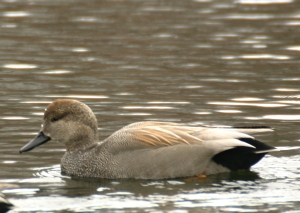Celebrating good duck news: Column from The Hour newspaper

Gadwall numbers are up 80 percent from their long-term average and nine percent over last year, according to a Fish and Wildlife spring survey.
Here is my column in The Hour (Norwalk, CT) newspaper today. The topic will be discussed Saturday on Bird Calls
By CHRIS BOSAK
For the Birds
Anyone who has followed this column for any reasonable amount of time knows my affinity for ducks.
I love when the first migrant ducks show up on our waters in the fall, enjoy the entire winter when ducks are abundant on open water, and dread the spring when the ducks disappear. I have an extremely modest — but valuable to me — duck decoy collection that is the favorite part of my basement. Actually my kids love the collection, too, and used to shun all the real toys and play with the decoys. I think they did it because they knew it drove daddy nuts.
Anyway, you get the picture. I love all birds, but ducks are a favorite of mine.
So when duck news comes across my email in the dead of summer, I’m interested.
News came out in late June of the U.S. Fish and Wildlife Service’s breeding ducks and habitats survey, which was conducted in May and early June. The numbers, according to preliminary reports, are very encouraging for ducks.
Duck populations are an estimated 11 percent higher — with 45.6 million ducks counted on the surveyed area — over last year’s estimate. Even better news is the 35 percent increase over the long-term average from 1955-2010.
Dale Humburg, chief scientist for the conservation group Ducks Unlimited, said in a release that the numbers are “nearly unprecedented.” The surveys took place in habitats such as boreal regions up north, prairies in the Midwest, and grasslands and ponds throughout the U.S. and Canada.
The wet winter and spring likely played a role, Ducks Unlimited officials said. Wet conditions allow ducks to breed later in the season.
The news wasn’t all good as habitat loss reared its ugly head as it often does when it comes to bird populations. This time, instead of development, it was the conversion of grasslands to croplands that cost ducks large tracts of potential breeding grounds in the Midwest. Experts, according to the DU press release, project that more than one million more acres will be lost in 2012-2013. Ugh.
Now for the species-specific data. (Duck data — does it get any more exciting than that?)
Of the 10 species reported, eight showed an increase or similar results to 2010. The other two? American wigeon and scaup were below their 10-year average. Wigeon are common sightings throughout the region in fall and scaup use Norwalk harbor during the winter.
On the other hand, northern shovelers and blue-winged teal reached record highs. Northern pintail — one of the more handsome ducks out there — recorded its highest number since 1980, but is below the North American Waterfowl Management Plan goal.
The spring survey, according to Ducks Unlimited, provides the basis for many management programs.
“I encourage everyone to celebrate this year’s good news as we recommit to the long-term conservation of waterfowl and waterfowl habitat,” Hamburg, the DU scientist, said.
Good news for ducks. I’ll drink to that.
• More than likely I’ll talk about this survey during Saturday’s Bird Calls radio show. See below for information on Bird Calls and be sure to tune in. Feel free to call in with a question or story about birds.
For the Birds runs Thursdays in The Hour. Chris Bosak can be reached via www.birdsofnewengland.com. His radio show, Bird Calls, air 3 to 4 p.m. Saturdays on WSTC/WNLK AM1400/1350 and www.wstcwnlk.com. Archives of Bird Calls may be found at www.birdcallsradio.com
